Seismic Behaviors of Prefabricated Reinforced Concrete Shear Walls Assembled with a Cast-in-Place Vertical Joint
Abstract
:1. Introduction
2. Experimental Work and Numerical Modeling
2.1. Preparation of Specimens
2.2. Test Method
2.3. Numerical Model
2.3.1. Material Compositions
2.3.2. Mesh Division and Interaction
3. Results Analysis and Discussion
3.1. Failure Pattern
3.2. Hysteretic Behavior
3.3. Enveloping Curve
3.4. Stress Maps of Concrete and Steel Bars
3.5. Bearing Capacity and Ductility
3.6. Energy Dissipation Ability
3.7. Stiffness Degeneration
4. Conclusions
- (1)
- The failure was in a shear pattern for the prefabricated shear walls with a straight, an L-shaped, or a convex cast-in-place concrete vertical joint. The cracks mainly distributed around the cast-in-place concrete vertical joint, which reduced the crushed area at the root of the prefabricated shear walls. The cast-in-place concrete bonded to the precast units well to ensure the ability to effectively transfer the shear stress.
- (2)
- Compared with the prefabricated shear wall with a straight vertical joint, the prefabricated shear walls with an L-shaped or a convex vertical joint exhibited a slight decrease in bearing capacity, ductility, and energy dissipation capacity. However, all the prefabricated shear walls met the cyclic performance requirements. The prefabricated shear walls under a higher axial compression ratio exhibited an increase in the bearing capacity and a decrease in ductility.
- (3)
- The stresses on both sides of the vertical joint were basically consistent, which ensured an even stress distribution across the prefabricated shear walls. The stress patterns aligned with the trend of crack extension, which resulted in a small difference in bearing capacity, stiffness degradation, ductility, and energy dissipation capacity. This demonstrates good agreement between the test and the numerical analysis. The finite element models built in this study can be used for the future parametric analysis of the cyclic performance of prefabricated shear walls.
Author Contributions
Funding
Data Availability Statement
Conflicts of Interest
References
- GB/T 51231-2016; Technical Standard for Assembled Buildings with Concrete Structure. China Building Industry Press: Beijing, China, 2016.
- JGJ/T398-2017; Standard for Design of Assembled Housing. China Building Industry Press: Beijing, China, 2017.
- JGJ 1-2014; Technical Specification for Precast Concrete Structures. China Building Industry Press: Beijing, China, 2014.
- Liu, S.; Li, Z.; Teng, Y.; Dai, L. A dynamic simulation study on the sustainability of prefabricated buildings. Sustain. Cities. Soc. 2022, 77, 103551. [Google Scholar] [CrossRef]
- Yang, Y.; Ding, X.; Liu, Y.; Deng, L.; Lv, F.; Zhao, S. Lateral pressure test of vertical joint concrete and formwork optimization design for monolithic precast concrete structures. Buildings 2022, 12, 261. [Google Scholar] [CrossRef]
- Li, C.; Yang, Y.; Su, J.; Meng, H.; Pan, L.; Zhao, S. Experimental research on interfacial bonding strength between vertical cast-in-place joint and precast concrete walls. Crystals 2021, 11, 494. [Google Scholar] [CrossRef]
- Singhal, S.; Chourasia, A.; Chellappa, S.; Parashar, J. Precast reinforced concrete shear walls: State of the art review. Struct. Concr. 2019, 20, 886–898. [Google Scholar] [CrossRef]
- Shen, S.D.; Pan, P.; Miao, Q.S.; Li, W.F.; Gong, R.H. Test and analysis of reinforced concrete (RC) precast shear wall assembled using steel shear key (SSK). Earthq. Eng. Struct. Dyn. 2019, 48, 1595–1612. [Google Scholar] [CrossRef]
- Sritharan, S.; Aaleti, S.; Henry, R.S.; Liu, K.Y.; Tsai, K.C. Precast concrete wall with end columns (PreWEC) for earthquake resistant design. Earthq. Eng. Struct. Dyn. 2015, 44, 2075–2092. [Google Scholar] [CrossRef]
- Du, H.; Jiang, J.; Han, M.; Sun, W. Experimental research on seismic behavior of assembled l-shaped perforated wall connected by soft cable. J. Build. Struct. 2019, 40, 119–127. [Google Scholar]
- Gu, Q.; Zhao, D.; Tan, Y.; Gao, H.; Deng, Q.; Wang, X. Experimental study on L-shaped precast concrete superposed shear walls under quasi-static cyclic loading with different axial compressive load ratios. Eng. Struct. 2022, 254, 113857. [Google Scholar] [CrossRef]
- Gu, Q.; Zhao, D.; Li, J.; Peng, B.; Deng, Q.; Tian, S. Seismic performance of T-shaped precast concrete superposed shear walls with cast-in-place boundary columns and special boundary elements. J. Build. Eng. 2022, 45, 103503. [Google Scholar] [CrossRef]
- Wang, X.; Dong, G.; Deng, Q.; Tan, Y.; Wen, S.; Gu, Q. Seismic performance and deformation mechanism of precast single-face superposed shear wall. J. Build. Eng. 2023, 80, 108026. [Google Scholar] [CrossRef]
- Zhang, Z.; Wang, C.; Li, S.; Liu, X.; Wang, D.; Cao, X.; Zhang, Y. Seismic performance of prefabricated concrete shear wall with fluted grouting and anchor joint. J. Build. Struct. 2020, 41, 276–285. [Google Scholar]
- Chu, M.; Liu, J.; Hou, J.; Ren, B.; Liu, M.; Qiu, G.; Wang, G. Experimental study on flexural performance of precast concrete shear walls built with precast two-way hollow slabs with vertical joints. J. Build. Struct. 2017, 38, 84–92. [Google Scholar]
- Chu, M.; Liu, J.; Hou, J.; Ren, B. Experimental study on shear behaviors and bearing capacity of shear walls built with precast concrete two-way hollow slabs with vertical joints. Eng. Mech. 2020, 37, 183–194. [Google Scholar]
- Chu, M.; Xiong, C.; Liu, J.; Sun, Z. Experimental study on shear behavior of two-way hollow core precast panel shear wall with vertical connection. Struct. Design. Tall. Spec. Build. 2020, 30, e1814. [Google Scholar] [CrossRef]
- Liu, J.; Wang, B.; Chu, M.; Zhang, P.; Wang, B. Influence of the axial load ratio on the mechanical behaviour of pre-fabricated concrete shear walls with Mortise-Tenon joints. Structures 2023, 53, 83–97. [Google Scholar] [CrossRef]
- Zhao, B.; Wu, D.; Zhu, H. New modular precast composite shear wall structural system and experimental study on its seismic performance. Eng. Struct. 2022, 264, 114381. [Google Scholar]
- GB 50010-2010; Code for Design of Concrete Structures. China Building Industry Press: Beijing, China, 2010.
- Dassault Systems SIMULIA Corp. Abaqus Theory Manual, Version 6.12; Dassault Systems SIMULIA Corp.: Providence, RI, USA, 2012. [Google Scholar]
- Ali, O.; Abbas, A.; Khalil, E.; Bigaud, D. A new robust equation for shear strength of GFRP-RC deep beams using hybrid experimental and synthetic data based-FE quasi-static analysis procedure. Eng. Struct. 2023, 293, 116652. [Google Scholar] [CrossRef]
- Wang, X.; Ma, S.; Wu, W.; Fang, J.; Chen, Z. Tensile damage development and constitutive relationship establishment of recycled coarse aggregate concrete based on a double-interface numerical model. Constr. Build. Mater. 2023, 392, 131908. [Google Scholar] [CrossRef]
- Bai, Y.; Yang, H.; Jia, J.; Mei, S. Finite element analysis on large-rupture-strain (LRS) FRP confined concrete based on modified concrete damaged plasticity model. J. Eng. Mech. 2023, 40, 129–143. [Google Scholar]
- American Concrete Institute. ACI Committee 318. Building Code Requirements for Structural Concrete (ACI 318-11) and Commentary; American Concrete Institute: Farmington Hills, MI, USA, 2011. [Google Scholar]
- Coronado, C.; Lopez, M. Sensitivity analysis of reinforced concrete beams strengthened with FRP laminates. Cem. Concr. Compos. 2006, 28, 102–114. [Google Scholar] [CrossRef]
- GB 50011-2010; Code for Seismic Design of Buildings. China Building Industry Press: Beijing, China, 2010.
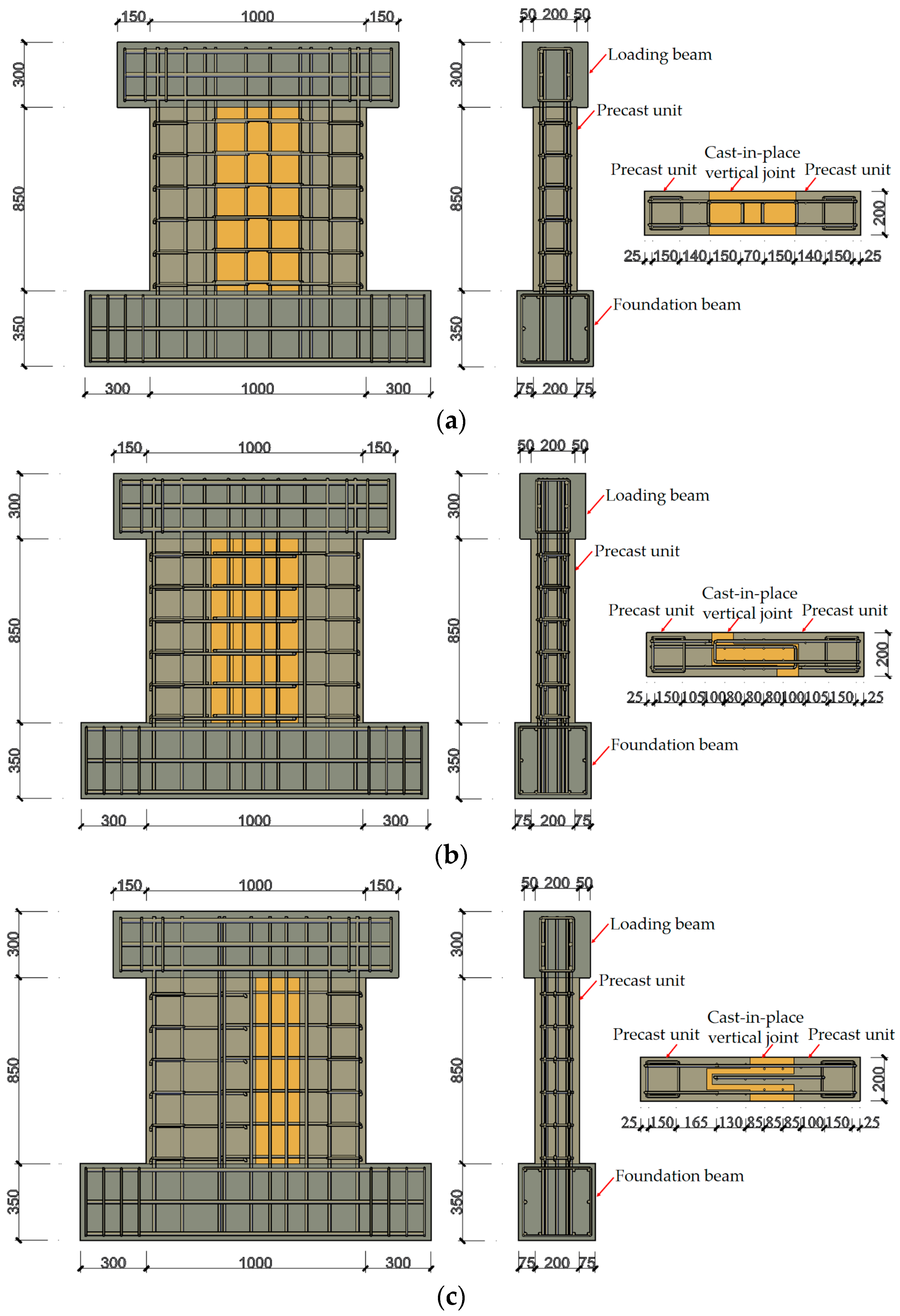
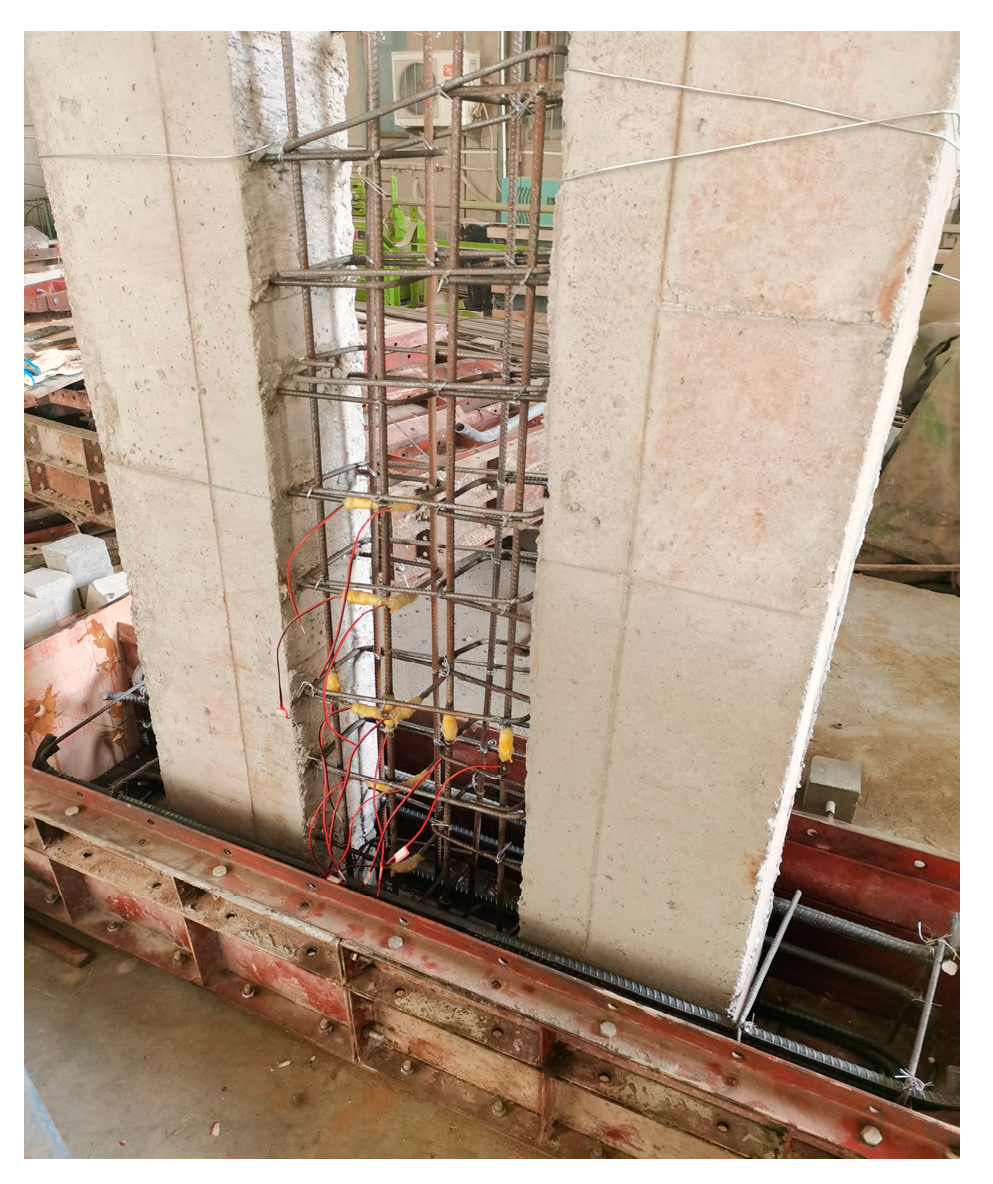


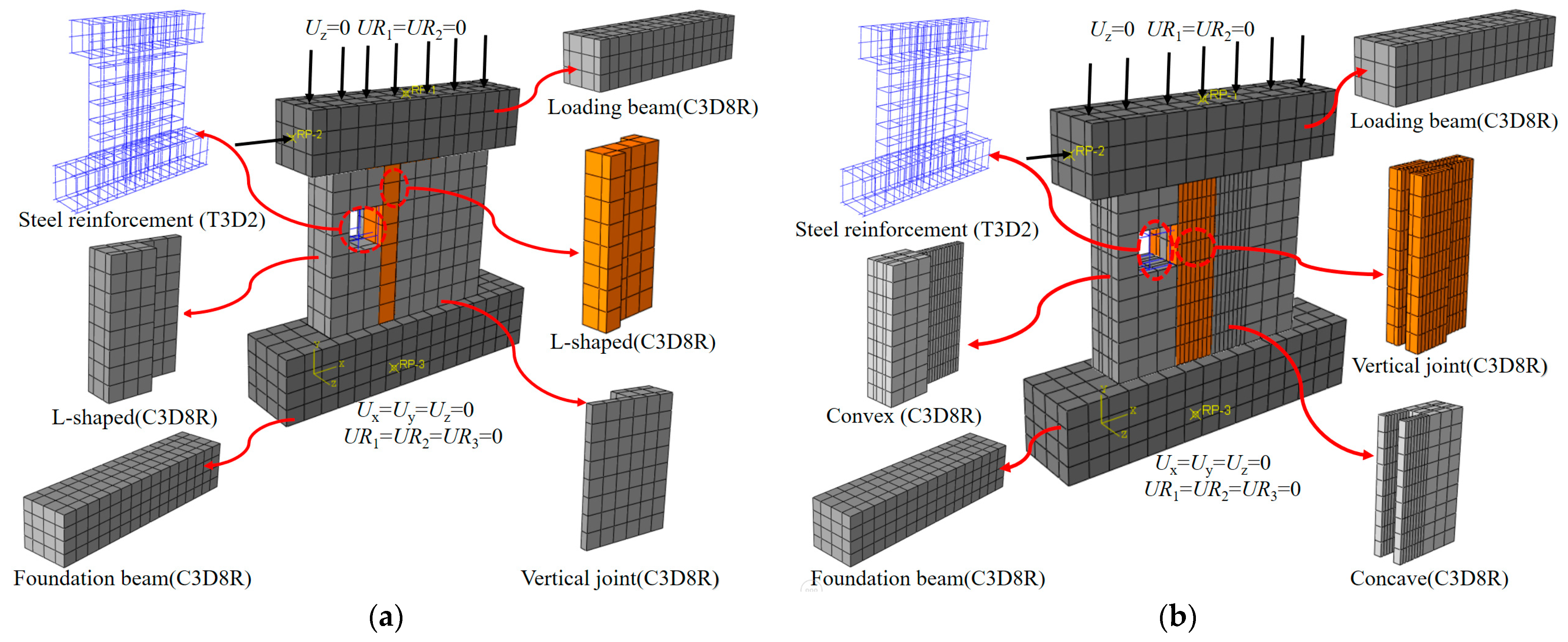
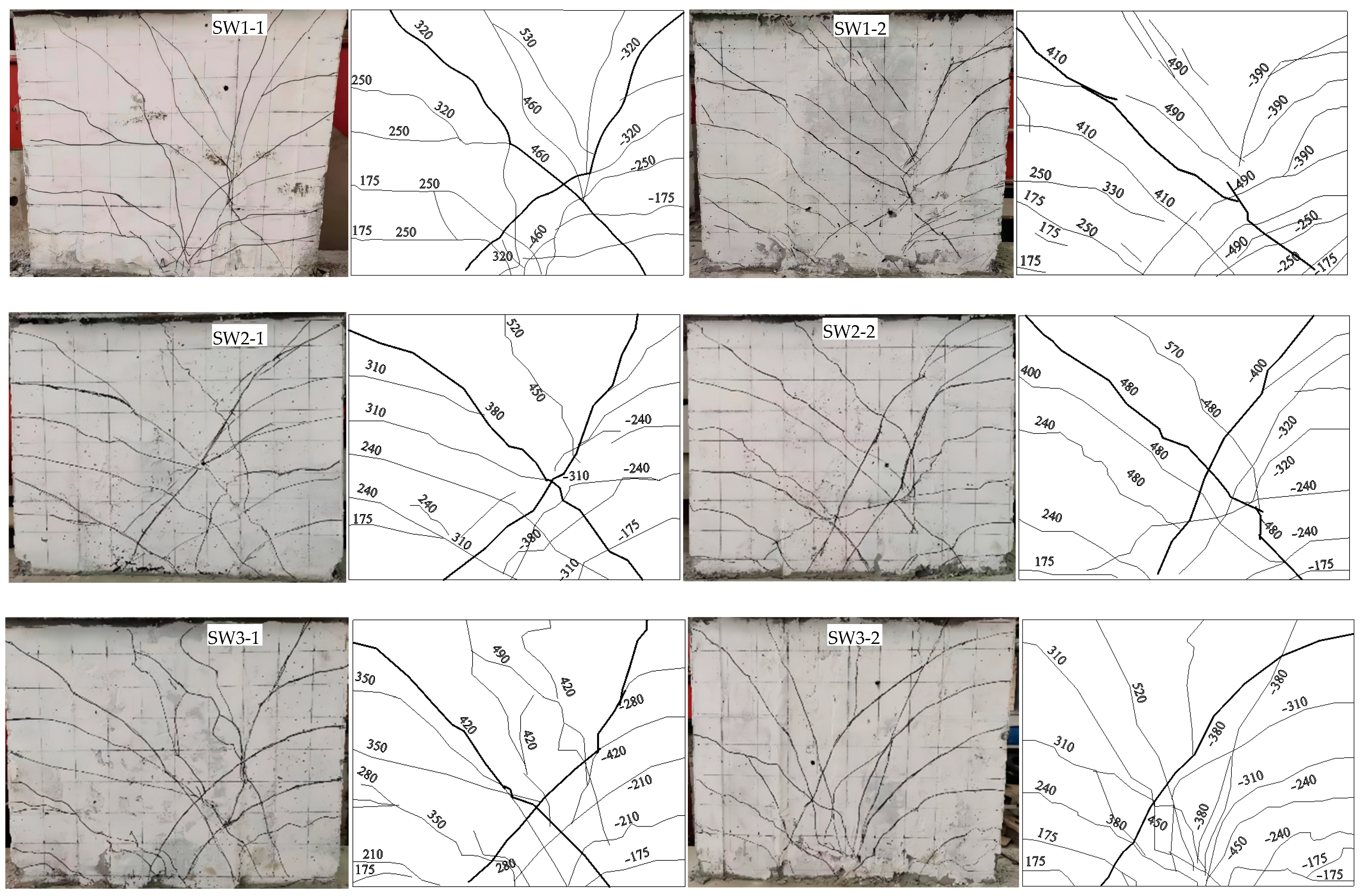





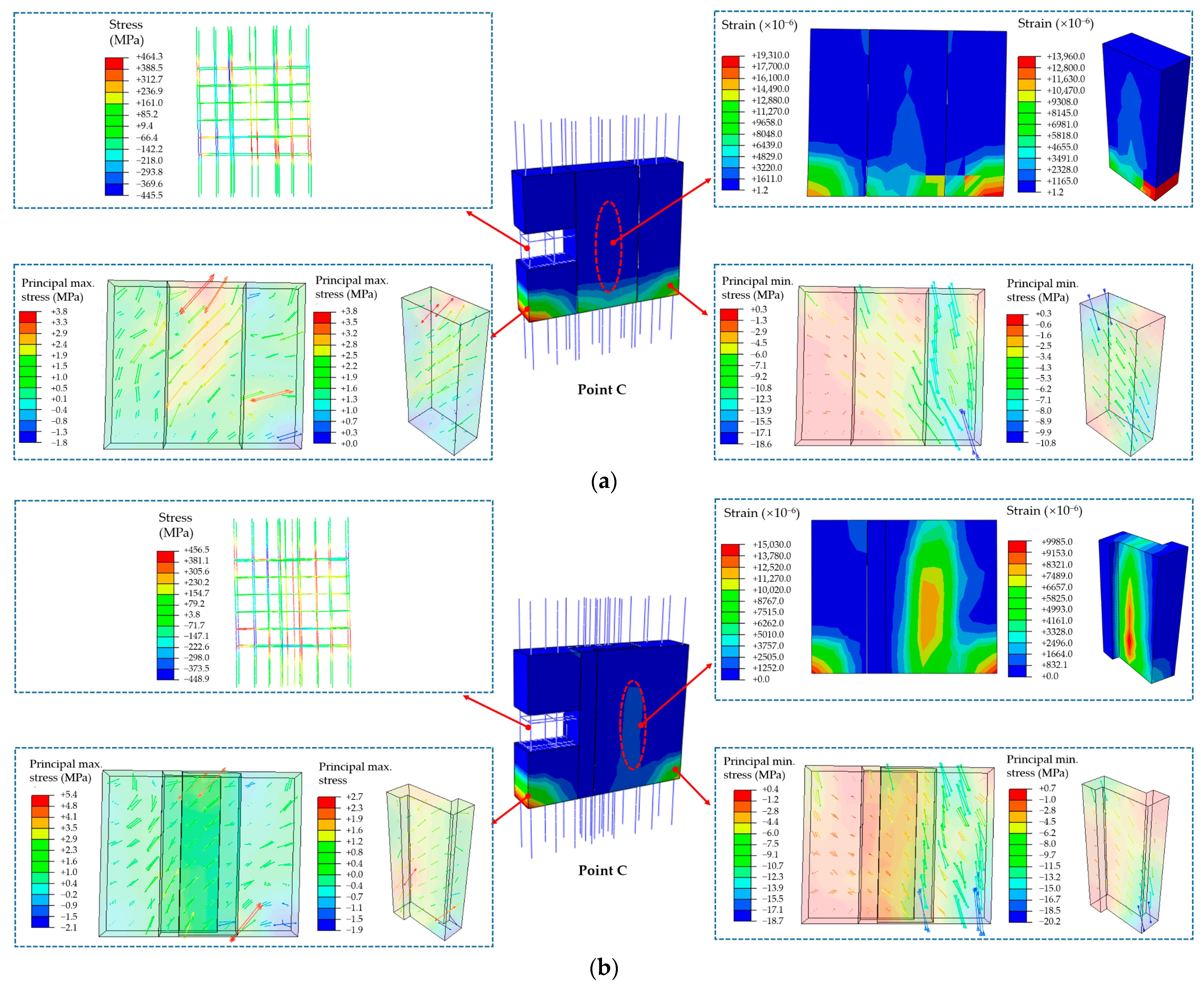

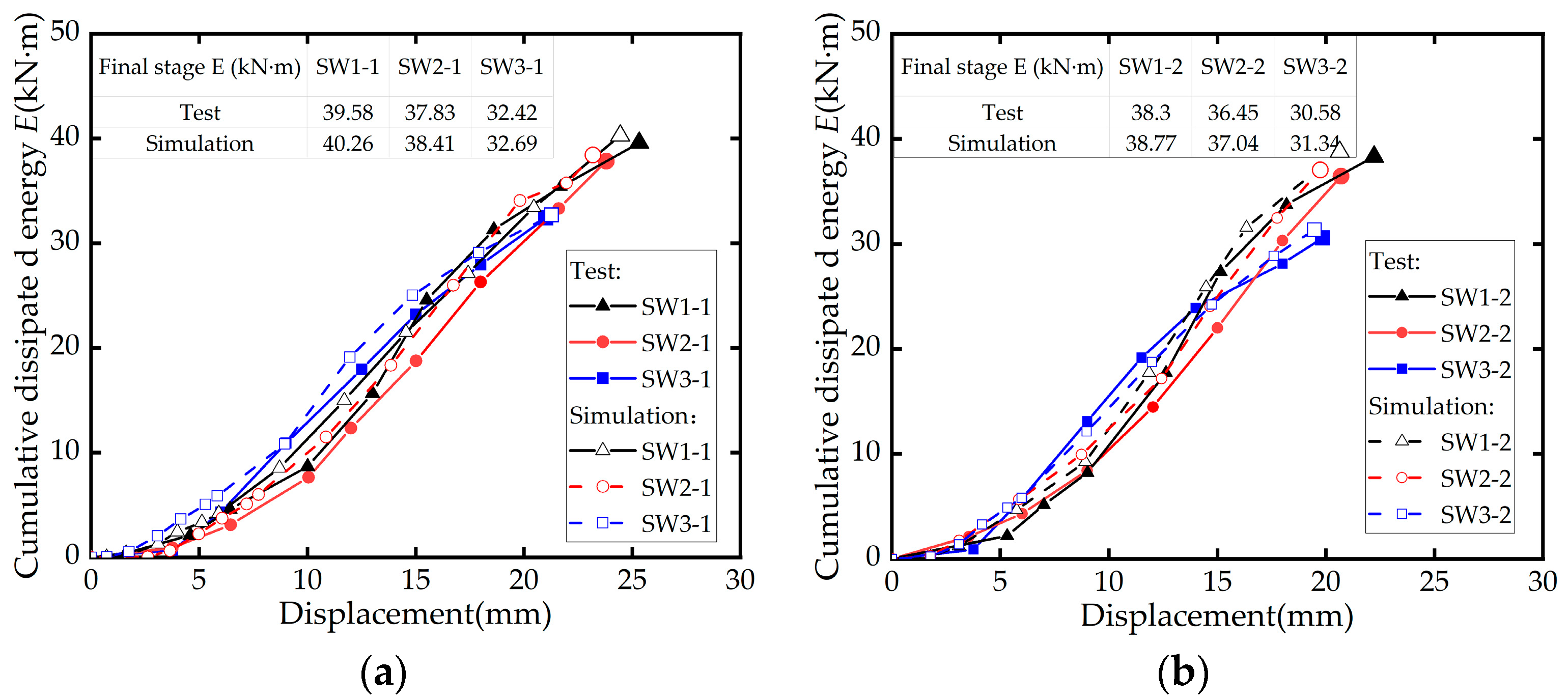

| Specimen | Vertical Joint Form | Axial Compression Ratio | Axial Force | Steel Reinforcements | |
|---|---|---|---|---|---|
| Longitudinal | Horizontal | ||||
| SW1-1 | Straight | 0.2 | 572 | 4ϕ10@150+8ϕ10+4ϕ8+4ϕ10@150 | 2ϕ8@150 |
| SW1-2 | 0.3 | 858 | 4ϕ10@150+8ϕ10+4ϕ8+4ϕ10@150 | 2ϕ8@150 | |
| SW2-1 | L shape | 0.2 | 572 | 4ϕ10@150+8ϕ8+8ϕ10+4ϕ10@150 | 2ϕ8@150 |
| SW2-2 | 0.3 | 858 | 4ϕ10@150+8ϕ8+8ϕ10+4ϕ10@150 | 2ϕ8@150 | |
| SW3-1 | Convex shape | 0.2 | 572 | 4ϕ10@150+10ϕ8+4ϕ10+4ϕ10@150 | 2ϕ8@150 |
| SW3-2 | 0.3 | 858 | 4ϕ10@150+10ϕ8+4ϕ10+4ϕ10@150 | 2ϕ8@150 | |
| Diameter (mm) | Yield Strength (MPa) | Ultimate Strength (MPa) | Elongation after Fracture (%) |
|---|---|---|---|
| 10 | 445 | 670 | 26 |
| 8 | 427 | 647 | 28 |
| 6 | 432 | 655 | 28 |
| Specimen | Cracked Load (kN) | Cracked Displacement (mm) | Yield Load (kN) | Yield Displacement (mm) | Ultimate Load (kN) | Ultimate Displacement (mm) | ||||||||||||
|---|---|---|---|---|---|---|---|---|---|---|---|---|---|---|---|---|---|---|
| Test | FEM | Test/ FEM | Test | FEM | Test/ FEM | Test | FEM | Test/ FEM | Test | FEM | Test/ FEM | Test | FEM | Test/ FEM | Test | FEM | Test/ FEM | |
| SW1-1 | 158 | 162 | 0.98 | 0.73 | 0.51 | 1.43 | 450 | 455 | 0.99 | 6.23 | 5.89 | 1.06 | 535 | 534 | 1.00 | 24.50 | 24.44 | 1.00 |
| SW1-2 | 178 | 175 | 1.02 | 0.76 | 0.52 | 1.46 | 498 | 502 | 0.99 | 5.73 | 5.40 | 1.06 | 580 | 571 | 1.02 | 21.61 | 20.63 | 1.05 |
| SW2-1 | 155 | 149 | 1.04 | 0.72 | 0.49 | 1.47 | 435 | 434 | 1.00 | 6.32 | 5.90 | 1.07 | 520 | 505 | 1.03 | 23.82 | 22.44 | 1.06 |
| SW2-2 | 170 | 168 | 1.01 | 0.75 | 0.48 | 1.56 | 488 | 478 | 1.02 | 5.75 | 5.93 | 0.97 | 565 | 547 | 1.03 | 20.73 | 19.73 | 1.05 |
| SW3-1 | 153 | 150 | 1.02 | 0.71 | 0.68 | 1.04 | 395 | 401 | 0.99 | 6.22 | 5.52 | 1.13 | 485 | 471 | 1.03 | 21.83 | 21.03 | 1.04 |
| SW3-2 | 165 | 162 | 1.02 | 0.73 | 0.71 | 1.03 | 425 | 434 | 0.98 | 6.01 | 5.35 | 1.12 | 515 | 514 | 1.00 | 19.94 | 19.47 | 1.02 |
| Specimen | Yield Displacement Δy (mm) | Ultimate Displacement Δu (mm) | θu | μ | ||||
|---|---|---|---|---|---|---|---|---|
| Test | FEM | Test | FEM | Test | FEM | Test | FEM | |
| SW1-1 | 6.23 | 5.89 | 24.50 | 24.44 | 0.024 | 0.024 | 3.93 | 4.15 |
| SW1-2 | 5.73 | 5.40 | 21.61 | 20.63 | 0.022 | 0.021 | 3.77 | 3.82 |
| SW2-1 | 6.32 | 5.90 | 23.82 | 22.44 | 0.024 | 0.022 | 3.76 | 3.80 |
| SW2-2 | 5.75 | 5.93 | 20.73 | 19.73 | 0.021 | 0.020 | 3.60 | 3.33 |
| SW3-1 | 6.22 | 5.52 | 21.83 | 21.03 | 0.022 | 0.021 | 3.50 | 3.81 |
| SW3-2 | 6.01 | 5.35 | 19.94 | 19.47 | 0.020 | 0.019 | 3.32 | 3.64 |
| Specimen | Energy Dissipation Ability (kN·mm) | Energy Dissipation Ratio | Initial Stiffness (K0) | Cracking Stiffness (Kc) | Yield Stiffness (Ky) | δy0 | Relative Value of δy0 |
|---|---|---|---|---|---|---|---|
| SW1-1 | 39,583.38 | 1.00 | 831.53 | 216.44 | 72.23 | 0.09 | 1.00 |
| SW1-2 | 38,302.19 | 0.97 | 832.36 | 234.21 | 86.91 | 0.10 | 1.11 |
| SW2-1 | 37,830.41 | 0.96 | 828.63 | 212.33 | 68.83 | 0.08 | 0.80 |
| SW2-2 | 36,448.85 | 0.92 | 829.53 | 226.67 | 84.87 | 0.10 | 1.25 |
| SW3-1 | 32,424.81 | 0.82 | 827.85 | 215.49 | 63.50 | 0.08 | 0.80 |
| SW3-2 | 30,579.69 | 0.77 | 826.82 | 228.77 | 70.72 | 0.09 | 1.13 |
Disclaimer/Publisher’s Note: The statements, opinions and data contained in all publications are solely those of the individual author(s) and contributor(s) and not of MDPI and/or the editor(s). MDPI and/or the editor(s) disclaim responsibility for any injury to people or property resulting from any ideas, methods, instructions or products referred to in the content. |
© 2023 by the authors. Licensee MDPI, Basel, Switzerland. This article is an open access article distributed under the terms and conditions of the Creative Commons Attribution (CC BY) license (https://creativecommons.org/licenses/by/4.0/).
Share and Cite
Yang, J.; Yang, Y.; Deng, L.; Sun, B.; Gu, Z.; Zeng, L.; Zhao, S. Seismic Behaviors of Prefabricated Reinforced Concrete Shear Walls Assembled with a Cast-in-Place Vertical Joint. Buildings 2023, 13, 3013. https://doi.org/10.3390/buildings13123013
Yang J, Yang Y, Deng L, Sun B, Gu Z, Zeng L, Zhao S. Seismic Behaviors of Prefabricated Reinforced Concrete Shear Walls Assembled with a Cast-in-Place Vertical Joint. Buildings. 2023; 13(12):3013. https://doi.org/10.3390/buildings13123013
Chicago/Turabian StyleYang, Junna, Yabin Yang, Lianchao Deng, Baoshan Sun, Zhongjia Gu, Lingxin Zeng, and Shunbo Zhao. 2023. "Seismic Behaviors of Prefabricated Reinforced Concrete Shear Walls Assembled with a Cast-in-Place Vertical Joint" Buildings 13, no. 12: 3013. https://doi.org/10.3390/buildings13123013
APA StyleYang, J., Yang, Y., Deng, L., Sun, B., Gu, Z., Zeng, L., & Zhao, S. (2023). Seismic Behaviors of Prefabricated Reinforced Concrete Shear Walls Assembled with a Cast-in-Place Vertical Joint. Buildings, 13(12), 3013. https://doi.org/10.3390/buildings13123013






